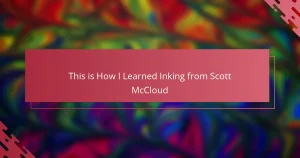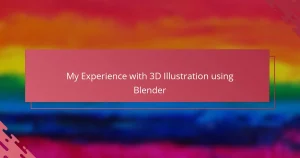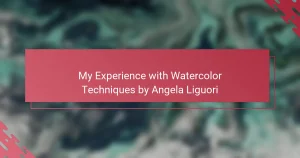Key takeaways
- Art Deco blends modern materials and craftsmanship, embodying elegance and innovation from the 1920s and 1930s.
- Key elements include bold geometric shapes, symmetry, and lavish ornamentation, creating a sense of movement and energy.
- Incorporating Art Deco in illustrations involves balancing detail with simplicity to maintain visual harmony.
- Utilizing digital tools alongside traditional techniques enhances the precision and textural qualities characteristic of Art Deco design.

Understanding Art Deco Style
Art Deco has always fascinated me with its bold geometry and lavish ornamentation. Its roots in the 1920s and 1930s bring to mind a time of elegance and innovation, combining modern materials with craftsmanship. Have you ever noticed how its sleek lines and symmetrical patterns create a sense of movement and energy, almost like a visual celebration of progress?
When I first studied Art Deco, I was struck by how it balances function and flamboyance. It’s not just about looking pretty; it’s about capturing an era’s optimism and sophistication through design. This style makes me think about how every detail—whether it’s a sunburst motif or chrome finish—tells a story about ambition and refinement.
Understanding these nuances helped me see Art Deco as more than a decorative trend. It’s a language of visual expression that speaks to creativity and confidence. Isn’t it amazing how a style born nearly a century ago still feels so fresh and inspiring today?

Identifying Art Deco Elements
Figuring out which elements truly represent Art Deco took some careful observation on my part. I started noticing how zigzags, chevrons, and stepped forms weren’t just random patterns—they were deliberate choices that echoed the era’s focus on structure and rhythm. Have you ever paused to consider why that fan-shaped sunburst keeps appearing everywhere in Art Deco designs? I found it fascinating how such motifs evoke both grandeur and movement.
What really helped me identify Art Deco elements was paying attention to symmetry and repetition. When I sketched out my illustrations, I realized that balance wasn’t just aesthetically pleasing; it gave the work a feeling of order amid the dynamic shapes. It’s like Art Deco communicates through repetition, guiding your eye along clean lines and geometric forms that feel both modern and timeless.
Texture and materials also played a big role in shaping my perception. I remember experimenting with metallic colors and glossy finishes to mimic the chrome and lacquer often used in Art Deco furniture and architecture. That shine and sheen added a layer of sophistication to my work, embodying the luxurious spirit that defines the style. Don’t you think those tactile qualities bring designs to life in a way flat colors never could?
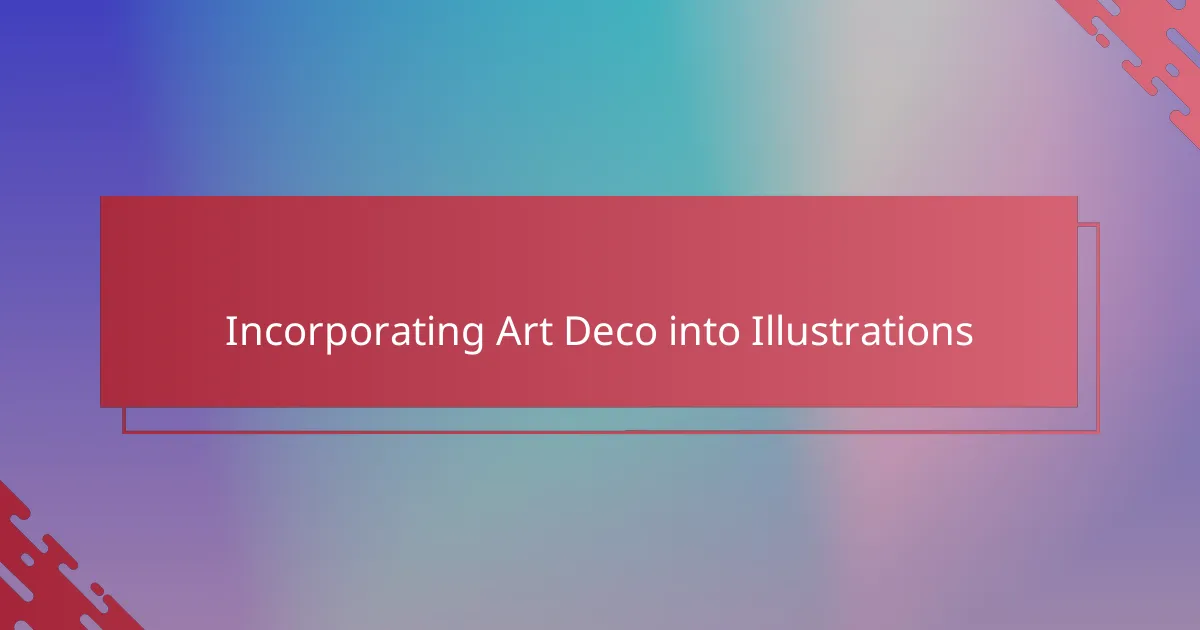
Incorporating Art Deco into Illustrations
Incorporating Art Deco into my illustrations meant embracing its iconic geometry without letting the style feel rigid. I found that playing with sharp angles and repeating motifs brought a rhythm to my work, almost like the image was breathing with the same energy that Art Deco embodies. Have you ever tried layering these patterns so they not only decorate but actually drive the composition forward? That’s where the real magic happens.
At times, I struggled with balancing ornamentation and simplicity. Art Deco’s lavish details can easily overwhelm a piece if not carefully controlled. What helped me was thinking of each element as a note in a symphony—too many notes clutter the melody, but the right ones add richness and depth. This mindset allowed me to use metallic accents and sunburst motifs sparingly, making them shine without stealing the spotlight.
Texture became another tool in my Art Deco arsenal. By blending glossy finishes and contrasting matte surfaces in my digital work, I mimicked the tactile feel of classic materials like chrome and lacquer. It’s amazing how these subtle touches transform flat illustrations into something you almost want to reach out and touch. Have you noticed how texture can elevate a simple line drawing into an immersive experience? That’s exactly the effect I aimed for.
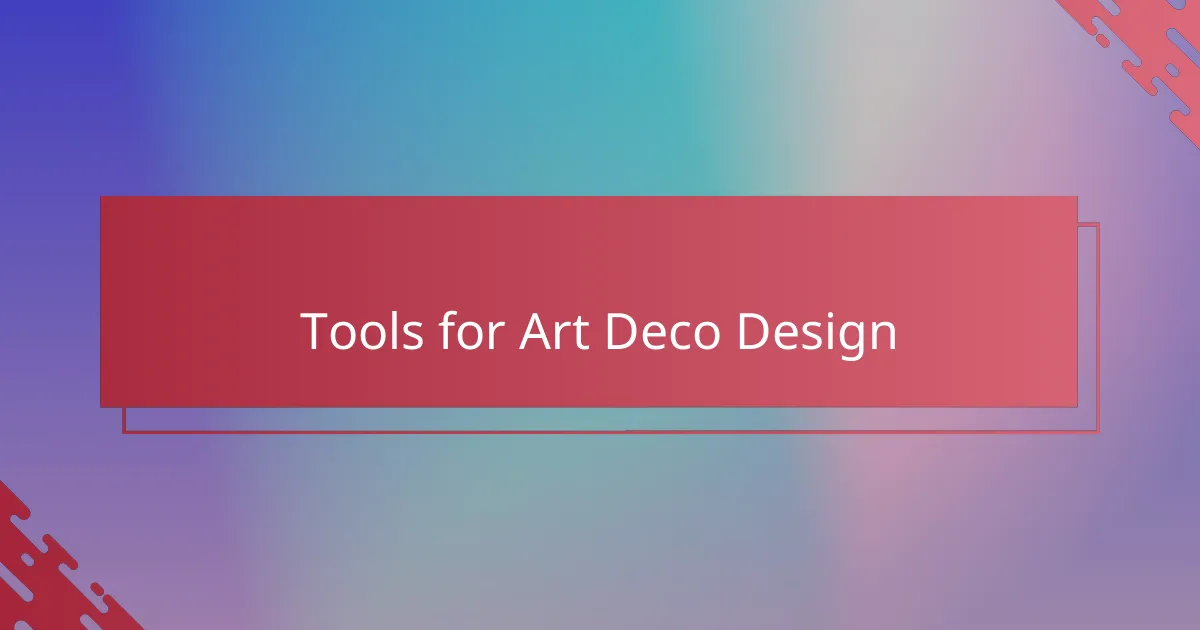
Tools for Art Deco Design
Working with Art Deco designs pushed me to explore specific tools that capture its essence. I quickly realized that vector illustration software, especially Adobe Illustrator, was indispensable because it allows me to create those precise geometric shapes and sharp lines that define the style. Have you ever tried to draw a perfect chevron or a symmetrical sunburst freehand? It’s nearly impossible without these digital aids.
Beyond software, I found custom brushes and pattern generators hugely helpful when building repetitive motifs like zigzags and stepped forms. These tools saved me hours, but more importantly, they kept the rhythm consistent throughout my work. It made me appreciate how technology can support, rather than hinder, a hand-crafted feel.
Sometimes, I step away from the screen to sketch on grid paper, which feels surprisingly grounding amid digital finesse. This tactile process helps me map out symmetry and balance intuitively, connecting me to Art Deco’s architectural roots. Isn’t it interesting how blending old-school tools with modern ones creates a richer design experience?
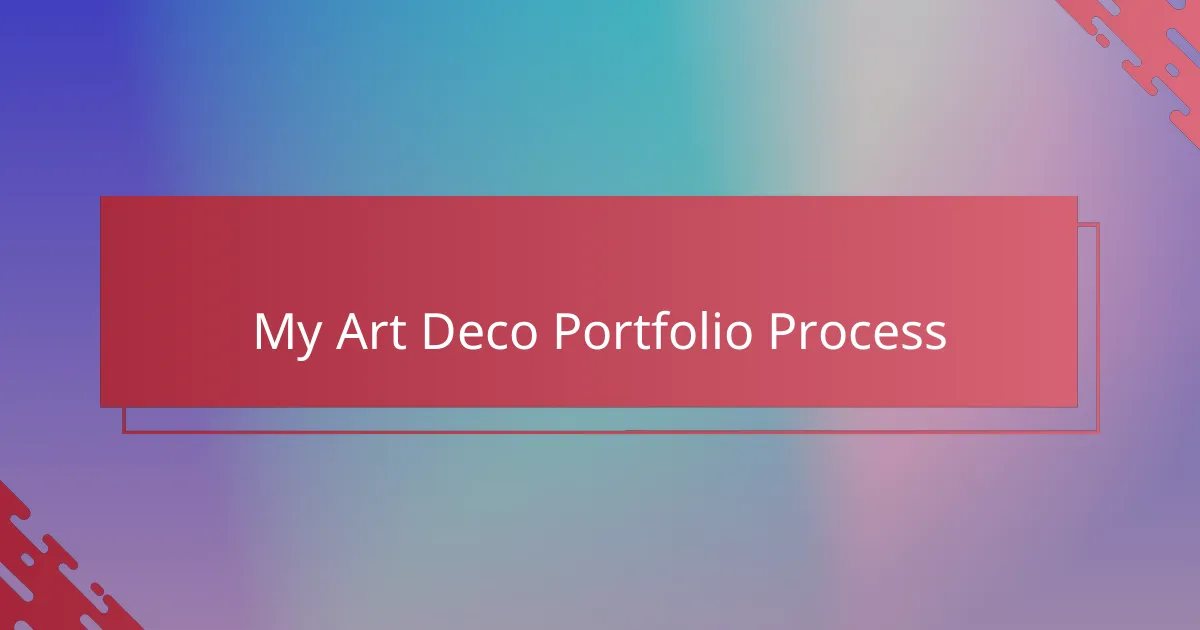
My Art Deco Portfolio Process
My Art Deco portfolio process began with endless iteration—redrawing and refining geometric patterns until they felt both precise and alive. I often found myself caught in the balance between exact symmetry and playful imperfection, wondering how much deviation was enough to keep the design interesting without losing that signature Art Deco polish.
I developed a habit of stepping back frequently, viewing the work from different angles and distances. This helped me catch moments where the composition either sang with rhythm or fell flat. Have you ever noticed how some arrangements just resonate, while others seem dull? For me, this constant calibration was key to bringing energy and cohesion into each piece.
Another part of my process involved layering metallic textures digitally, experimenting with light and shadow to capture the glossy sheen of classic Art Deco materials. It was almost meditative, watching how subtle gradients and reflections could transform a simple shape into something rich and tactile. Do you think texture can really change how a flat illustration feels? In my experience, it’s a game-changer.
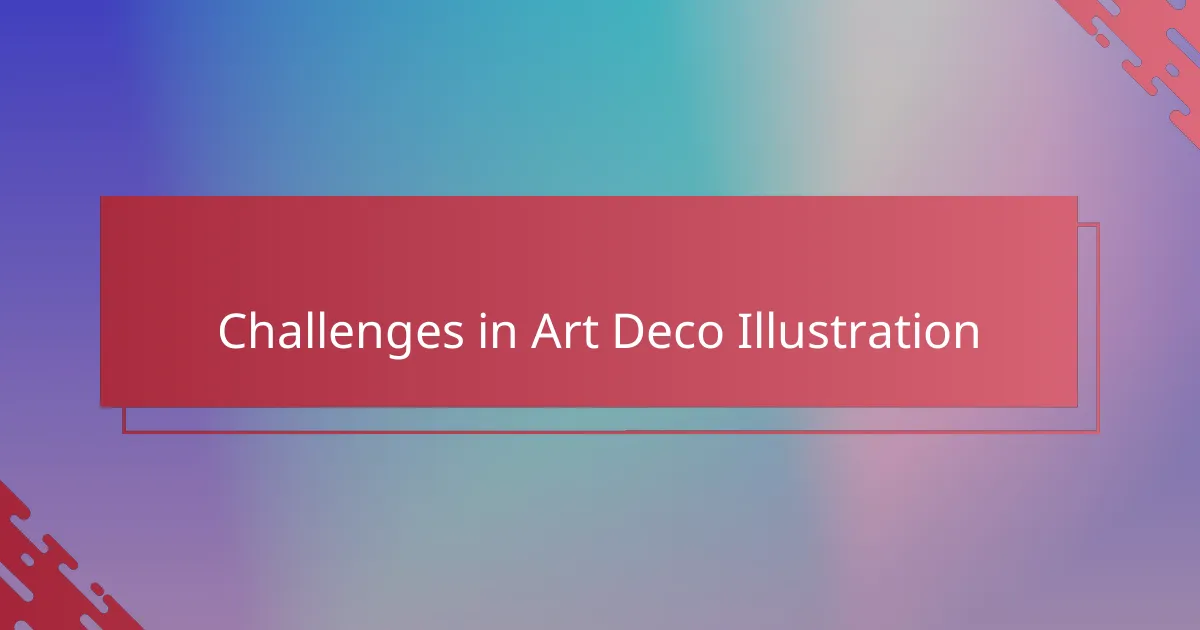
Challenges in Art Deco Illustration
Working within the Art Deco style sometimes felt like trying to capture lightning in a bottle. I often wrestled with its intricate details—those lavish ornaments can be tricky to balance without overwhelming the illustration. Have you ever found yourself wondering how to keep the elegance without turning your design into a chaotic mess? That push and pull challenged me to think critically about restraint and emphasis in every stroke.
Another challenge was staying true to Art Deco’s precise geometry while injecting my own artistic voice. The style demands sharp lines and perfect symmetry, yet too much rigidity risked making the work feel stiff. In those moments, I learned to embrace small imperfections that added warmth without losing that polished look. Isn’t it fascinating how subtle deviations can bring life to something so structured?
Finally, replicating the tactile qualities of classic Art Deco materials digitally was no easy feat. Trying to evoke the shimmer of chrome or the gloss of lacquer challenged my technical skills and patience. I remember countless tweaks to gradients and highlights before achieving the right balance. Have you ever spent hours just chasing the perfect shine? That process taught me how vital texture is in conveying mood and authenticity.
